Related Research Articles

Agnatha is a superclass of jawless fish in the phylum Chordata, subphylum Vertebrata, consisting of both present (cyclostomes) and extinct species. The group is sister to all vertebrates with jaws, known as gnathostomes.
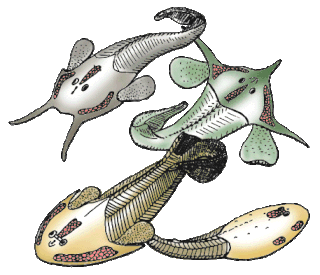
Ostracoderms are the armored jawless fish of the Paleozoic. The term does not often appear in classifications today because it is paraphyletic or polyphyletic, and thus does not correspond to one evolutionary lineage. However, the term is still used as an informal way of loosely grouping together the armored jawless fishes.

Thelodonti is a class of extinct jawless fishes with distinctive scales instead of large plates of armor.

Thelodus is an extinct genus of thelodont agnathan that lived during the Silurian period. Fossils have been found in Europe, Asia and North America. Unlike many thelodonts, species of Thelodus are known not only from scales, but from impressions in rocks. Some species, such as the Canadian T. inauditus, are thought to be comparable in size to other thelodonts, i.e., from 5 to 15 centimeters in length. The scales of the type species, T. parvidens of Silurian Great Britain, however, reach the size of coins, and, if proportioned like other thelodonts, such as Loganellia, the living animal would have been about one meter in length.

Phlebolepis is an extinct thelodont agnathan genus belonging to the family Phlebolepididae. Whole fossils are found in Early Silurian (Llandovery) aged strata from Saaremaa, Estonia. Phlebolepis elegans was average-sized for a thelodont, 7 cm long.

Furcacauda is a genus of thelodontid agnathan from the Lower Devonian of Canada, and is the type genus of the order Furcacaudiformes. Furcacaudiform thelodontids were deep water jawless vertebrates with symmetrical fork and lobed-finned tails and scales smaller than typical loganellid and nikoliviid thelodonti scales. Furcacaudiform thelodonts are noted as having a laterally compressed body, large anterior eyes, slightly posterior, lateral, and vertical to a small mouth, and a condensed curved row of branchial openings (gills) directly posterior to the eyes. Many but not all had laterally paired fins. Wilson and Caldwell also note the presence of a caudal peduncle and a long caudal fin made of two large lobes, one dorsal and one ventral separated by 8 to 14 smaller intermediate lobes, giving the appearance of a striated half-moon shaped tail resembling the tail of a heterostracan. A large square cavity within the gut connecting a small intestine to an anal opening lead many to believe that it is this genus that exhibits the first vertebrate stomach. According to Wilson and Caldwell their discovery, based on sediment infillings of fossils of the Furcacauda heintze, gives credence to the evolutionary development of stomach before jaws.
Cometicercus is an extinct genus of thelodont which lived in Canada during the Early Devonian period.
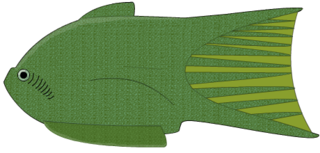
Drepanolepis is an extinct genus of thelodont which lived in Canada during the Early Devonian period.
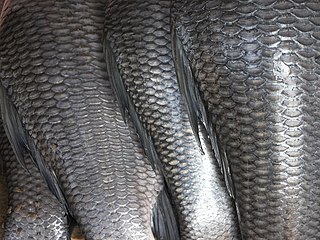
A fish scale is a small rigid plate that grows out of the skin of a fish. The skin of most fishes is covered with these protective scales, which can also provide effective camouflage through the use of reflection and colouration, as well as possible hydrodynamic advantages. The term scale derives from the Old French "escale", meaning a shell pod or husk.
Longodus is an extinct genus of thelodont, placed in its own family – Longopdidae – which existed in what is now Estonia during the Ludlow epoch of the upper Silurian period. The type and only species is Longodus acicularis.
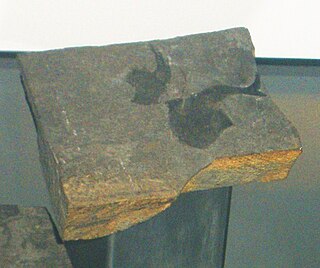
Lanarkia is a genus of extinct thelodont agnathan which existed in what is now Scotland and Canada during the upper Silurian period.
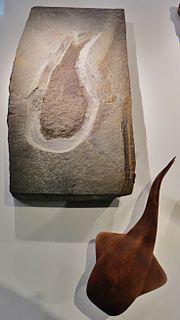
Loganellia is a genus of jawless fish which lived between 430-370 million years ago, during the Silurian and Devonian periods of the Paleozoic. Loganellia belonged to the Thelodonti class and like other Thelodonts possessed scales instead of plate armor.

Furcacaudiformes is an extinct order of jawless fish in the class Thelodonti.
Coelolepis is an extinct genus of jawless fish of the Silurian.

Thelodontiformes is an extinct order of jawless fish of the Silurian.

Furcacaudidae is a family of thelodontid agnathan from the Lower Devonian. It is the type family of the order Furcacaudiformes.

Archipelepidiformes is an order of extinct jawless fishes in the class Thelodonti.

Archipelepis is a genus of extinct thelodont agnathans, and are the most primitive recognized thelodonts of which whole body fossils are known. Fossils of bodies and scales are currently known from Late Telychian to Wenlock-aged marine strata of northern Canada.

Phlebolepididae is an extinct thelodont agnathan family in the order Thelodontiformes.
References
- ↑ Obruchev, D. V. "Fundamentals of Paleontology. Vol. 11, Agnatha, Pisces. Israel Program for Scientific Translations, Jerusalem, 1967." (1967): 825.